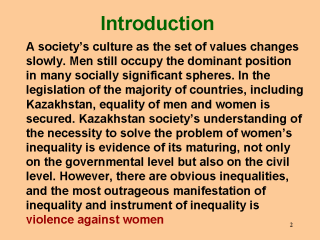| front |1 |2 |3 |4 |5 |6 |7 |8 |9 |10 |11 |12 |13 |review |
 |
The survey “Canadian Survey of Problem of Violence
against Women” conducted from 1991 – 1993 (phone interviews, sampling of 123,000
women) showed that 25% of married women aged 18 and older had been exposed to different
forms of violence. Zabelina T. Y., Israelyan E. V., Shvedova N. A.: Canada and the problem of family violence: twenty years of struggle, www.owl.ru/win/research*** There are countries whose main religion is Islam and whose legislation either does not protect women from physical and sexual violence, or merely offers formal protection. For example, Turkey’s criminal code does not contain any statements protecting women from violence (although the Supreme Court considered several international documents and declarations, and made a conclusion about the disparities between international documents and statements in Turkey’s criminal and civil codes). Libyan legislation does not have any norms aimed at protecting women, since, according to the country leadership, violence against women “is not a dangerous phenomenon” in the country. Why don’t these countries adopt international documents and declarations? In our opinion, the reason is contained in different approaches to this problem, where the key issue is the definition of the notion of violence against women. |